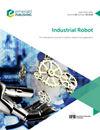双四边形移动机构的设计与运动分析
IF 2.5
4区 计算机科学
Q3 ENGINEERING, INDUSTRIAL
Industrial Robot-The International Journal of Robotics Research and Application
Pub Date : 2022-05-31
DOI:10.1108/ir-12-2021-0290
引用次数: 0
摘要
目的提出一种基于双四连杆机构的整体变形轧制机构。双四边形移动机构(DQMM)具有两种可切换的工作模式,可用于穿越不同的地形或爬过障碍物。设计/方法/方法DQMM的主体由一个共享公共连杆的双四连杆机构和位于四连杆机构两端的两个对称转向平台组成。转向平台使DQMM不仅具有转向能力,而且具有侦察能力,可以通过在转向平台上携带相机等传感器来实现侦察能力。通过控制DQMM的变形,可以在履带式滚动模式和爬障模式两种工作模式之间切换,实现滚动和爬障功能。建立了动态仿真模型,验证了该方法的可行性。结果基于运动学分析和仿真结果,采用履带滚动方式实现DQMM的运动功能,采用爬障方式在连续台阶等结构化地形中爬越障碍物。在物理样机上验证了两种工作模式的可行性。本文的工作是将“整体封闭移动连杆机构”应用于小型移动机构领域的新探索。通过多模式组合,提高了对不同地形的适应能力和爬越障碍的能力。本文章由计算机程序翻译,如有差异,请以英文原文为准。
Design and motion analysis of double quadrilateral mobile mechanism
Purpose
The purpose of this paper is to propose an overall deformation rolling mechanism based on double four-link mechanism. The double quadrilateral mobile mechanism (DQMM) has two switchable working modes which can be used to traverse different terrains or climb over obstacles.
Design/methodology/approach
The main body of the DQMM is composed of a double four-link mechanism which sharing a public link and two symmetrical steering platforms which placed at both ends of the four-link mechanism. The steering platforms give the DQMM not only steering ability but also reconnaissance ability which can be achieved by carrying sensors such as cameras on steering platforms. By controlling the deformation of the DQMM, it can switch between two working modes (tracked rolling mode and obstacle-climbing mode) to achieve the functions of rolling and obstacle-climbing. Dynamic simulation model was established to verify the feasibility.
Findings
Based on the kinematics analysis and simulation results of the DQMM, its moving function is realized by the tracked rolling mode, and the obstacle-climbing mode is used to climb over obstacles in structured terrains such as continuous stairs. The feasibility of the two working modes is verified on a physical prototype.
Originality/value
The work of this paper is a new exploration of applying “overall closed moving linkages mechanism” to the area of small mobile mechanisms. The adaptability of different terrains and the ability of obstacle-climbing are improved by the combination of multi-modes.
求助全文
通过发布文献求助,成功后即可免费获取论文全文。
去求助
来源期刊
CiteScore
4.50
自引率
16.70%
发文量
86
审稿时长
5.7 months
期刊介绍:
Industrial Robot publishes peer reviewed research articles, technology reviews and specially commissioned case studies. Each issue includes high quality content covering all aspects of robotic technology, and reflecting the most interesting and strategically important research and development activities from around the world.
The journal’s policy of not publishing work that has only been tested in simulation means that only the very best and most practical research articles are included. This ensures that the material that is published has real relevance and value for commercial manufacturing and research organizations. Industrial Robot''s coverage includes, but is not restricted to:
Automatic assembly
Flexible manufacturing
Programming optimisation
Simulation and offline programming
Service robots
Autonomous robots
Swarm intelligence
Humanoid robots
Prosthetics and exoskeletons
Machine intelligence
Military robots
Underwater and aerial robots
Cooperative robots
Flexible grippers and tactile sensing
Robot vision
Teleoperation
Mobile robots
Search and rescue robots
Robot welding
Collision avoidance
Robotic machining
Surgical robots
Call for Papers 2020
AI for Autonomous Unmanned Systems
Agricultural Robot
Brain-Computer Interfaces for Human-Robot Interaction
Cooperative Robots
Robots for Environmental Monitoring
Rehabilitation Robots
Wearable Robotics/Exoskeletons.

 求助内容:
求助内容: 应助结果提醒方式:
应助结果提醒方式:


